Spin bowling ‘variations’ can be deadly. For spin bowlers, a variation is a delivery that will behave in a different way to their regular deliveries. It could spin in a different direction, it could not spin at all, or it could be bowled quicker on a different trajectory. There are many different options, and the best spin bowlers will often have a number of different variations they can use to bamboozle a batsman!
So, what are the different spin bowling variations called? And what makes each variation different to the others? I’ve put together a list of all of the main ones that you will encounter in the game of cricket, and in this post I’m going to give you the lowdown on each of them! If you’re a spin bowler, hopefully this list will give you some of the basic information you need to start working on developing these deliveries for yourself! If you’re a batsman, it might help prepare you to face these deliveries! Here is the list of spin bowling variations:
- The Googly
- Top Spinner (Leg Break Bowlers)
- The Flipper
- The Slider
- The Arm Ball
- Top Spinner (Off Break Bowlers)
- The Doosra
- The Carrom Ball
A lot of times throughout this post I will reference the ‘conventional leg break grip’ or ‘the standard off break grip’. If you’re reading this and realise that you don’t know what either of those grips look like you may want to check out one or both of the following posts! For leg break bowlers you can find a great breakdown of the leg break grip by clicking here! As for off break bowlers, I have broken down the grip required in this post! I think these posts are a great starting point for spinners!
The Googly
The googly (or the ‘wrong un’, as it is often called) is bowled by leg break bowlers, and it is perhaps the most famous spin bowling variation.
For a right arm leg break bowler, their normal leg break delivery will spin from right to left – away from a right handed batsman. A googly bowled by a right arm leg break bowler will spin the opposite way, from left to right and in towards the body of a right handed batsman. For left arm leg break bowlers (often known as left arm chinaman), the directions are reversed. Their normal leg break deliveries spin from left to right – in towards the body of a right handed batsman. A googly bowled by a left arm leg break bowler would spin from right to left – taking it away from the body of a right handed batsman.
How To Bowl The Googly
Some of you may be interested in what it takes to actually bowl the googly so let me take you through a few basic steps:
- The grip required for the googly is the same as it is for a conventional leg break.
- The bowler should go through their normal spin bowling delivery stride. This is usually a few paces long and allows the bowler to gather some momentum in order to propel the ball towards the batsman.
- As the arm comes over during the bowling action and the ball is about to be released, the bowler must rotate his arm so that the back of the hand is facing towards the batsman. This is the key part of the delivery!
- If you’re a right arm leg break bowler bowling to a right handed batsman, the seam on the ball should now be pointing towards the fine leg area.
- If you’re a left arm leg break bowler bowling to a right handed batsman, the seam on the ball should now be pointing in the direction of first slip.
- Once you are sure you have the correct arm and hand position, spin is imparted on the ball by the flick of the wrist as the ball exits the back of the hand. The flick of the wrist combined with the ring finger being dragged across the top of the ball should lead to you getting some decent revolutions on your delivery.
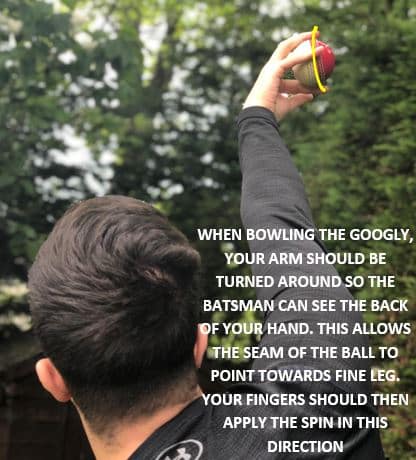
This variation is incredibly difficult to bowl accurately, and must be practiced regularly if you want to be comfortable enough to bowl it during a game! At its best it is remarkably effective because of how hard it is for the batsman to pick. Bowled at full speed, a batsman must watch the bowlers hand incredibly closely to pick up the difference in hand position! This is why you see so many batsmen in international cricket misjudging the googly and either being bowled, stumped, or caught after not making a proper connection with the ball!
I’ve also written a much more detailed post about how to bowl the googly, click here if you’d like to read it! In that post I’ll tell you more about what it takes to bowl the googly, and I also cover some strategic stuff like where you should be aiming to bowl it, as well as which types of batsmen you should be targeting! If you want to learn more about this delivery, it’s a must read!
Top Spinner (Leg Break Bowlers)
Top spinners are primarily bowled by leg break bowlers, however off break bowlers do have their own version, so I’ll cover that shortly!
A top spinner (or ‘over spinner’ as you’ll sometimes hear it referred to) is an effective variation for a leg break bowler because instead of spinning away from or into the batsman, it generally maintains its original line and goes straight on towards the batsman! It also allows the bowler to get the ball to dip as well as extract a little bit more bounce from the surface! Basically it bounces upwards more than it bounces sideways!
How To Bowl The Top Spinner
Here are some steps for leg break bowlers that should help you bowl the top spinner:
- The grip for the top spinner is exactly the same grip that is used for the conventional leg break delivery.
- The bowler should go through their normal delivery stride. This is usually a few paces long and allows the bowler to gather some momentum in order to propel the ball towards the batsman.
- As the bowling arm comes over and the ball is about to be released, the hand must be rotated slightly so that the back of the hand is facing in the direction of your head. If you have done this correctly, it will mean that the thumb-side of your hand will be facing directly towards the batsman. Again, the hand position during release is the most important part of getting this delivery right! Example photos have been included below.
- For right arm leg break bowlers, the palm of the hand should be pointing east. For leg arm leg break bowlers, the palm of the hand should be pointing west.
- When releasing the ball, spin is applied due to the flick of the wrist, followed by the dragging of the ring finger down the front side of the ball.
- Remember, for this delivery, you are not aiming to get any side spin on the ball – just top spin! Basically, the ball should be spinning forwards, directly towards the batsman! To do this the bowler must try to get the wrist and the fingers rotating over the top of the ball as the ball leaves the back of the hand. The aim should be to get the seam to remain nice and upright during the flight of the ball.

As I already mentioned, the top spinner allows the bowler to get a little extra bounce on their deliveries. It also may feel as if the ball comes on to the bat a little bit quicker than usual! A good top spin delivery puts the batsman at risk of bat pad dismissals due to inside edges, as well as top edges if they’re playing a cross-batted shot! Plus, if you can get the ball to travel through the air with good seam position you can also get a little bit of swing on the delivery…making it even more difficult to play!
If you’re a batsman and you’re wanting to learn how to pick variations like the top spinner, the googly or the arm ball as they leave the bowler’s hand, then I’ve compiled all of my favourite tips and tricks on how to do that into one detailed 30-page Ebook that I’m now giving away for FREE! This Ebook lays out the methods you can use to pick variations, and then goes through each variation one by one, showing you exactly what you need to look out for! If you’re interested in getting a copy – head over to giveaway.cricketershub.com and follow the instructions to download one. I promise you it’ll help improve your game against spin!
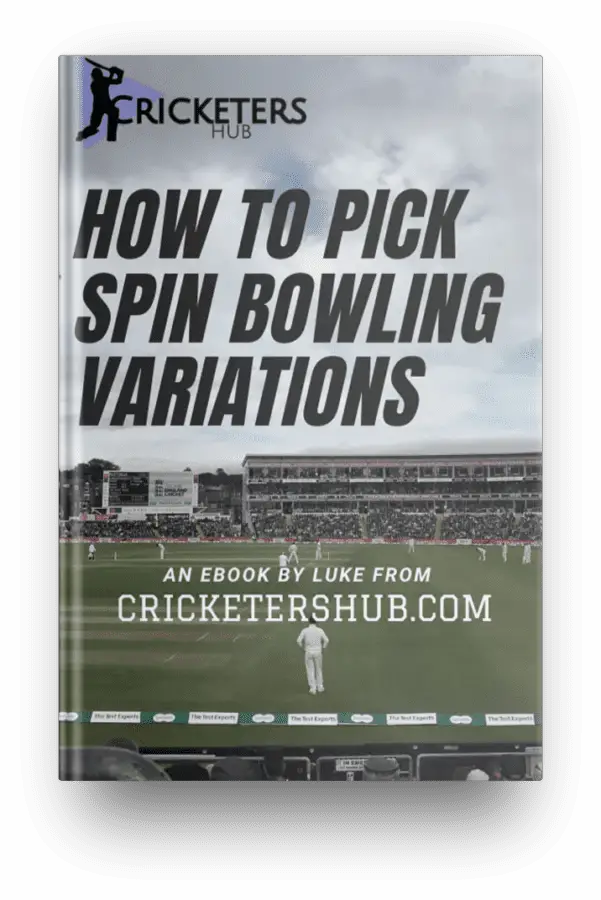
Head over to giveaway.cricketershub.com to secure your copy!
The Flipper
The flipper is one of the more complicated variations that leg break bowlers bowl! It is a ball that is delivered with a very unorthodox release, making it arguably the hardest variation to master for leg break bowlers. The way the ball is released causes it to shoot out of the hand quickly and on a much flatter trajectory. This ball is much more likely to skid low off the pitch due to the backspin that is being applied to the ball!
How To Bowl The Flipper
Here are my steps I think you should follow in order to bowl the flipper:
- To grip used for the flipper is basically the same as it is for the standard leg break. However, this time I would recommend holding the ball more with the finger tips rather than having it gripped tightly to the palm of your hand. This can be seen below!
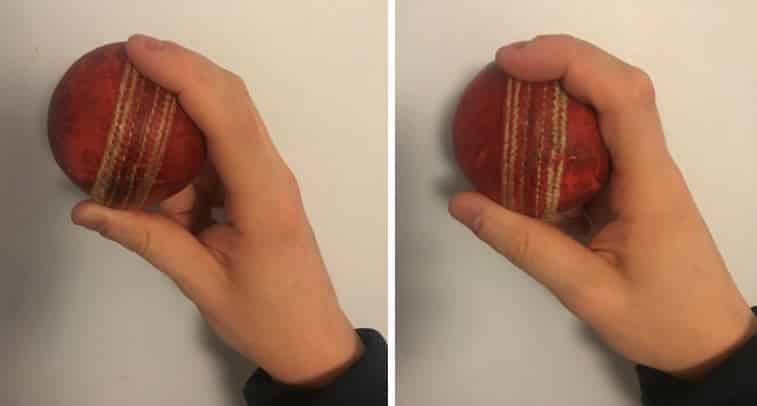
- The bowler should go through their normal delivery stride. This is usually a few paces long and allows the bowler to gather some momentum in order to propel the ball towards the batsman.
- As the bowling arm comes over and the ball is about to be released, the hand should be positioned in roughly the same way it is for a top spinner. The back of the hand should be facing in the direction of your head, and you should be showing the thumb-side of your bowling hand to the batsman.
- As the ball is being released the thumb is squeezed towards the index and middle fingers of the bowling hand. The thumb is squeezed over the top of the ball, while the index and middle fingers push down on the lower side of the ball, causing it to shoot out of the front of the hand with plenty of backspin applied!
- Now, If you’ve read my post that covers the correct grip for a leg break, then you will know that the thumb is not directly involved when you are bowling those deliveries. It does not even necessarily need to be in contact with the ball. However, the use of the thumb is the most vital part of bowling the flipper!
Shane Warne said that the best way to practice this delivery is to practice the motion of clicking your fingers together, and then begin to include a cricket ball in the process. As you release the ball you should be copying this ‘clicking the fingers’ movement. This is what causes the ball to shoot out of your hand fast! I’ll include some photos below to try to illustrate the process, but if all else fails, I’d recommend watching one of Shane Warne’s tutorial videos. You can find a good one here.
The flipper is a useful variation because it deceives the batsman with its flight, speed and lack of spin. Shane Warne really was the master of it, and he used it to prove that non-spinning deliveries can be just as deadly as the ones that spin a long way! Due to the awkward way the ball is released, this ball will also require a large amount of practice time! I know that in one of his videos Warne said you should try to master your leg break, googly and top spinner before you look to work on this one! If I were you I’d listen to the master!
The Slider
The slider is another variation for leg break bowlers! It is a delivery that looks very similar to a leg break during the release and the flight of the ball, but instead of getting the ball spinning diagonally forwards like we do during a leg break, a slider gets the ball spinning in a slightly different direction. I’ve used the diagram below to illustrate how the slider should be spinning differently to a standard leg break. This direction of spin means that once it hits the pitch, it holds its line and ‘slides’ on to the batsman.
How To Bowl The Slider
Here’s some tips for bowling the slider:
- The grip used for the slider is the exact same grip as is used to bowl a leg break.
- The bowler should go through their normal delivery stride. This is usually a few paces long and allows the bowler to gather some momentum in order to propel the ball towards the batsman.
- As the ball comes over and the ball is about to be released, the bowler must position his arm so that the palm of their hand will be facing straight forwards towards the batsman. From here, instead of imparting side spin on the ball and making the seam spin horizontally, the bowler must angle his wrist slightly by turning it inwards towards his body and spin the ball ever so slightly backwards!
- The spin is imparted in the same way as it is with the leg break, using the flick of the wrist as well as the ring finger to get the revolutions on the ball.
I have again included some photos to illustrate how the slider is bowled, but to echo what I said in the previous section about the flipper, it may be worth watching a video where Shane Warne explains how to bowl this ball too! The video I linked earlier also included tips for bowling the slider.
Due to the slight backspin on the ball, it means that the delivery is more likely to hold its line and slow down once it hits the pitch. The thing that makes the slider the most dangerous is how much it looks like a leg break! Even though the bowlers’ release for the leg break and the slider are different, they are incredibly small differences which are difficult for the batsmen to pick up at full speed. If a batsman fails to pick up on the change of hand and wrist position, he must try to detect the change in the angle of rotation on the ball! The leg break will usually be spinning forwards at an approximate 45-degree angle, whereas the slider will be spinning backwards slightly. If the batsman fails to pick up any of these cues…you may just get yourself a wicket!
The Arm Ball
The arm ball is probably the most common variation bowled by off break bowlers. It is a non-spinning ball that is bowled more like a delivery from a medium pacer than a spinner! It will usually be bowled a bit faster than an off break, and will maintain its line once it hits the pitch. It also presents an opportunity for the off break bowler to get swing in the air if they choose to bowl the delivery with the seam upright!
How To Bowl The Arm Ball
My tips for bowling the arm ball are as follows:
- The arm ball requires a slight change of grip from the usual off break. Instead of having their index and middle fingers gripped across the seam like usual, they will turn the ball around so that their index finger now lies alongside the seam like a fast bowler! The middle finger is mostly taken off the ball, and is only used for support! I’ve included a photo of this grip below.
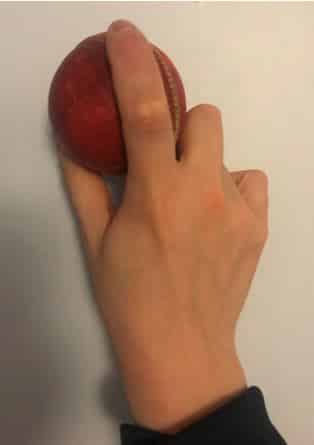
- The bowler should go through their normal delivery stride. This is usually a few paces long and allows the bowler to gather some momentum in order to propel the ball towards the batsman.
- As the bowling arm rotates and the ball is about to be released, the off break bowler will keep their wrist behind the ball and try to push the delivery through like a fast bowler. The seam can be tilted slightly in a direction of the bowler’s choice, and the index finger will be used to apply a backwards rotation to the ball along that axis, just like a fast bowler.
- If bowled correctly, the seam will remain upright and mean there is more chance of the bowler achieving movement in the air! This makes the ball harder for the batsman to play.
The arm ball is a dangerous off break variation as it challenges the batsman’s perception of the speed and spin on the ball. If the batsman gets used to playing the slower off break deliveries, a quicker arm ball could cause them to mistime their shots. Also, if the batsman is anticipating the off spin on the ball, and then the ball doesn’t turn at all and just continues on its original path, this can lead to the batsman missing the ball altogether! Combine all this with the fact that the arm ball is relatively simple to practice and can be bowled fairly easily, and you have yourselves a very valuable variation!
Top Spinner (Off Break Bowlers)
The top spinner for off break bowlers follows the same principles as the top spinner for leg break bowlers. It is a delivery where the spinner does not impart any sideways spin on to the ball, instead making the ball rotate forwards, in a straight line towards the batsman. This means that when the ball pitches it will not deviate laterally, it will maintain its original line instead! The top spin on the ball also allows off break bowlers to get the ball to dip in the air as well as get some extra bounce off the pitch.
How To Bowl The Top Spinner
Here are a few steps for off break bowlers to follow to bowl their own version of the top spinner:
- The grip for the top spinner is exactly the same as the one used for the standard off break. The off break grip is covered in detail in the post I linked to earlier. You can find it by clicking here.
- The bowler should go through their normal delivery stride. This is usually a few paces long and allows the bowler to gather some momentum in order to propel the ball towards the batsman.
- As the bowling arm comes over and the ball is about to be released, the hand should be turned so that the palm is facing inwards towards the bowlers body. If the hand is positioned correctly, then the side of the hand that features the little finger should be pointing directly towards the batsman they are bowling to.
- From here, the index and middle fingers are dragged forcefully down the front of the ball as it leaves the hand, imparting forward rotations on to the ball. It is necessary to keep the bowling arm nice and high when bowling this delivery. This allows you to get your fingers over the top of the ball better and allows you to properly impart top spin. Bowlers with actions that do not have their bowling arm up as high may struggle to bowl the top spinner.
This delivery offers numerous advantages to the bowler. It offers you the opportunity to toss the ball up more and get it to dip on the batsman, and if you manage to get the ball spinning with a good upright seam position you may get a little bit of drift in the air! This is an especially dangerous delivery for batsmen who are playing cross batted shots due to the fact that they can easily top edge the ball.
The Doosra
The Doosra is the most famous variation that off break bowlers possess, and it also brings some controversy with it! The Doosra turns in the opposite direction to the standard off break. So, for right arm off break bowlers, the Doosra will turn from right to left – away from the body of a right handed batsman. For a left arm orthodox bowler, a Doosra would turn from left to right – in towards the body of a right handed batsman!
The controversy surrounding the Doosra exists because the delivery cannot easily be bowled with a straight arm! Certain bowlers like Johan Botha have been banned from bowling the delivery because their bowling actions were not judged to be legal when bowling it. The laws of cricket allow a bowler to bend their arm at the elbow joint up to a limit of 15 degrees when bowling. Certain cricketers have exceeded this limit while bowling the Doosra. It should be noted though, that the bowler who originally popularised the Doosra – Saqlain Mushtaq, was never disciplined for his action!
How To Bowl The Doosra
There are numerous ways to bowl the Doosra but in this section I’m going to give some tips for bowling it in the same style as bowlers like Saeed Ajmal:
- The grip used for the delivery is exactly the same as the grip used for the normal off break. Although it should be noted that certain bowlers modify this slightly in certain ways.
- The bowler should go through their normal delivery stride. This is usually a few paces long and allows the bowler to gather some momentum in order to propel the ball towards the batsman.
- As the bowling arm comes over and the ball is about to be released, the bowler should turn his arm so that he is showing part of the back of his hand to the batsman, and cock his wrist slightly (I’ll include pictures of this below). Getting the arm and wrist in this position may require the bowler to contort his shoulder a little bit.
- If the arm is in the right position and the right arm off break bowler is gripping the seam in the correct way, the seam of the ball should now be pointing towards first slip for a right handed batsman.
- For a left arm orthodox bowler that is about to bowl a Doosra to a right handed batsman, the seam of the ball should be pointing towards fine leg during release.
- Keep in mind that having the arm slightly bent during this phase of the delivery definitely makes the Doosra easier to bowl. It is very difficult to propel the ball down the pitch at a good speed in this way when you are bowling with a totally straight arm. Just remember that your arm can’t bend too much, 15 degrees is the maximum!
- From here, the index and middle fingers are used to impart the spin. utilises the index and middle fingers to spin the ball. One thing I noticed as I studied Saeed Ajmal’s Doosra is the fact that he uses the index finger to forcefully ‘flick’ the ball as it leaves his hand. You’ll see his middle finger grips the ball quite tightly while the index finger is slightly bent. This is a slightly change from the conventional off break grip.
- As the middle finger begins the process of rotating the ball, the index finger is used to flick the ball and apply the direction of spin.
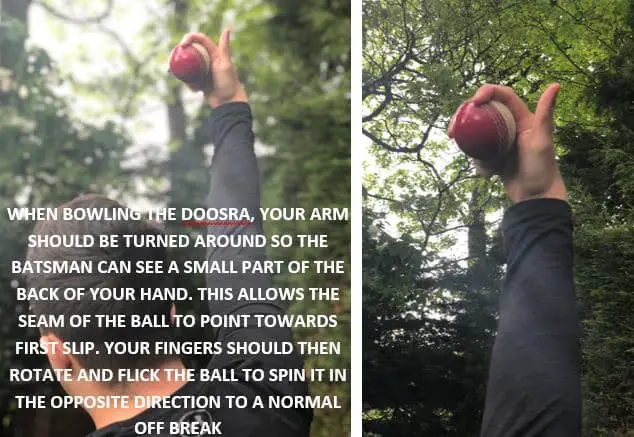
In the studying I’ve done, Ajmal didn’t get the Doosra to spin a long way, but a tiny bit of spin, combined with the fact that the ball was very hard for batsmen to detect was one of the reasons he was so successful when bowling it!
The Carrom Ball
The Carrom ball has re-appeared in cricket in the last decade thanks to off break bowlers like Ajantha Mendis and Ravi Ashwin. It spins in the same direction as the Doosra! This means that right arm off break bowlers will be spinning the Carrom ball away from the body of right handed batsmen, whilst left arm orthodox bowlers will be spinning the Carrom ball in towards the body of a right hander.
How To Bowl The Carrom Ball
Here are my tips that should help you bowl the Carrom Ball:
- Although the Carrom ball spins in the same direction as the Doosra, the action needed to bowl it is different. This starts with the grip. The most common grip used to bowl the Carrom ball involves the use of the thumb, the index and the ring finger. The index finger is used to secure the ball at the top, and the thumb and ring finger are used to secure the ball at the bottom. Check the photo below to see this grip and how it is used to spin the ball!

- The bowler should go through their normal delivery stride. This is usually a few paces long and allows the bowler to gather some momentum in order to propel the ball towards the batsman.
- As the bowling arm comes over and the ball is about to be released the bowler must extend and straighten their bent middle finger, rolling it up the edge of the ball. At the same time, the bowler will pull down on the opposite side of the ball with their thumb. This action applies the spin to the ball and ‘shoots’ the ball out of the front of the hand.
The Carrom ball is always bowled out of the front of the hand, with the palm of the hand facing the batsman. Conversely, when bowling an off break, the palm of the hand will be at roughly a 45-degree angle to the batsman.
There is also another method that is used to bowl the Carrom ball which is a slight variation to the one I just explained. I should also mention that I think this one is a little more difficult to master! In this version the bowler will once again grip the ball between the thumb, index and ring fingers. However, this time the fingers are positioned differently. I’ve used the photos below to show you this. The middle finger is bent behind the ball, ready to flick one side of it and apply the spin. As the ball is about to be bowled, the index and ring finger release their grip whilst the middle finger flicks one side of the ball, this action applies the revolutions needed for spin.
It is unlikely that the carrom ball will spin a huge amount, but this is often better for bowlers as they will have more control over where they are bowling. I’d recommend watching videos of Ajantha Mendis and Ravi Ashwin bowling to see where they look to pitch the ball, and how they set batsmen up with their mix of off breaks and carrom balls.
The Carrom ball will take a lot of practice to get right! Often when you start bowling it, your fingers will not be strong enough to propel the ball to the other end of the pitch with the right amount of pace. But as we know from most of my posts, if you keep working and practicing consistently, any cricket skill is achievable!
Conclusion
So, there is my breakdown of spin bowling variations! As one of my final points I’d like to echo something that a lot of professional spinners often say…and that is that often the best variation is the one that you don’t intend to bowl! Sometimes, for reasons that aren’t obvious to the bowler or the batsman, certain balls just refuse to spin. Certain balls hit cracks on the pitch and change direction massively. Certain deliveries will hit the pitch and get twice the normal level of bounce. Cricket is unpredictable, and sometimes these ‘variations’ that occur due to factors involving the ball, the pitch and the general environment are even more dangerous than variations that we are intending to bowl! Your aim as spin bowlers should be to get the ball to pitch in dangerous areas. Then if something unexpected does happen, it’s more likely to benefit you!
Lastly, I’d like to remind you that your variation deliveries will be so much more effective if you focus on making your action repeatable. Basically, what I mean by this is that you should try to make all of your deliveries look identical to the batsman, so that your variations are harder to pick up. If there is a really obvious difference in your run up or your body position when bowling them, then the batsman is likely to see that and prepare themselves for what they are about to face!
